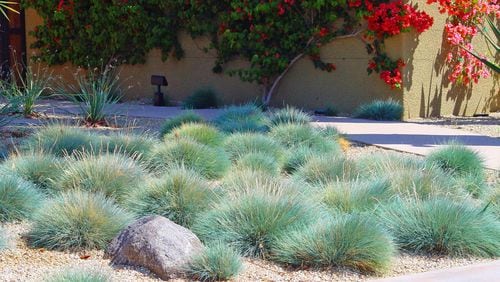Growing up in midcentury California, we’d see the spiky sapphire domes growing at homes in San Francisco, Los Angeles and San Diego. Large Japanese communities had grown up in all these ports. Many of them ran exceptional small neighborhood nurseries that specialized in Asian plants, bonsai and landscaping. Gradually the influence of their cultural designs became more prevalent in Los Angeles.
Out of the suffering in World War II, the Sunset Magazine garden style emerged, which blended elements of this Japanese garden legacy with clean lines of modern homes. Since childhood, the one plant that best achieved this synthesis in my mind is blue fescue. Though not a Japanese plant per se, it was picked up in these communities to use in Japanese dry gravel streambeds and small gravel and rock yards. The only ornamental grass available at the time was pampas grass and residents are still fighting the remnants of these monster Argentinean grasses a century later.
The beauty of Festuca glauca is it originates in the south of France to maintain both with surprising cold hardiness coupled with a tolerance of dry heat. Its home in limestone soils and sandstone crevices shows why it is a small grass, the species about 10 inches tall and a foot wide. This makes blue fescue a perfect companion for other Mediterranean species, as well as most succulents, which share similar water requirements.
The earliest use of these puffs was in the late 1950s, when gardeners filled problem open areas between driveway and front door with dry stream beds of natural cobbles. There’d be a small tree, a Japanese maple or for spring a tulip magnolia. Boulders created balance when accented by these little blue grasses as individuals and in colonies. It was common to add a few dark green irises to this template composition to imply the presence of water in dry climates.
When blue fescue blooms, its character changes. Needle fine flower stems rise many inches above the foliage topped with flowers identical to those big grasses but in miniature. They grow pale with age until the top becomes a blonde haze over the blue dome that vibrates with the breeze. They are stunning backlit by the setting sun. Many prefer to trim these to keep the blue sphere perfectly shaped, particularly for precise modern designs.
There are many different named varieties of Festuca glauca that offer larger sized plants or more or less blue color. Most are reliably hardy in Zone 4. Special blue fescues are bred for heavy soils and moist climates of northern Europe because they prefer rapid drainage and a drier season. Getting the right one for your microclimate is key to longevity: about four years. ‘Elijah Blue’ (Zone 4) has long been used in Western horticulture and is widely available, but your local garden center will verify which ones do best where you live.
With so many gardens using stone and gravel these days, this little blue grass is key to achieving great looks in small spaces without a lot of water. Where there is adequate rainfall they will thrive, but in most areas regular irrigation is required.
Blue fescue makes a great container plant for the contemporary or modern terrace, roof garden or use at poolside, where its vivid color is not dependent on flowers to look its best. Uniformity of growth allows some interesting opportunities for repetitive elements. Their texture and form is the perfect offset for dark green columnar cactus and small golden barrels.
With so many gardens using stone and gravel these days, this little blue grass is key to achieving great looks in small spaces without a lot of water. Just remember that though fescue is evergreen, you’ll want to shear it back gently at the end of winter to renew the foliage. Then all that’s left to do is wait for the blooms and decide whether or not you keep the flowers.
———
Maureen Gilmer is an author, horticulturist and landscape designer. Learn more at www.MoPlants.com
About the Author






